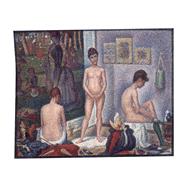Georges Seurat, 1859-1891
, by Herbert, Robert L.; Cachin, Francoise; Distel, Anne; Stein, Susan Alyson; Tinterow, Gary- ISBN: 9780300199888 | 0300199880
- Cover: Paperback
- Copyright: 6/25/2013
To mark the centenary of Georges Seurat's death in 1891, the Réunion des Musées Nationaux/Musée d'Orsay and The Metropolitan Museum of Art organized a landmark retrospective, Georges Seurat, 1859–1891, which will be seen on both sides of the Atlantic. In this exhibition and publication, such masterpieces as Parade de cirque, Cirque, and Jeune femme se poudrant, and an extraordinary group of seascapes testify to Seurat's pictorial ambitions. His splendid drawings in conté crayon place him, with Ingres, among the greatest draftsmen of the nineteenth century. These sheets and the beautiful series of small paintings on wood—his croquetons (little sketches)—give a more intimate view of Seurat. A large number of works are exhibited together for the first time, thanks to the generosity of private collectors.
This publication is meant to stimulate a fresh view of Seurat as well as to display his work. A century after Seurat's death, we are now able to correct some of the myths that grew up around him. Because he died at the age of thirty-one, he was long believed to have produced only a few pictures and to have died of consumption or some other frailty (so tenacious is the romantic paradigm of an early death). To the contrary, he was tall for his era (five feet, nine and one-half inches), and his friends always described him as being robust, but he ultimately succumbed to an epidemic of virulent diphtheria. As for his productivity, from his one decade of maturity there survive six huge canvases and sixty smaller ones, about 170 wood panels, 230 completed drawings, and fourty-five studies or fragmentary drawings, among other works. Harder to overcome than the myth of a frail, unproductive artist is the idea that Seurat's work was all but abstract, that the heart of his art lay not in his subjects but in his geometric compositions which presented summary types rather than individual humans. This book contests that Seurat's types are not "abstract"—that they are not the residue of a purely formal instinct but are brilliant visual distillations of psychological and social meanings. [This book was originally published in 1991 and has gone out of print. This edition is a print-on-demand version of the original book.]






